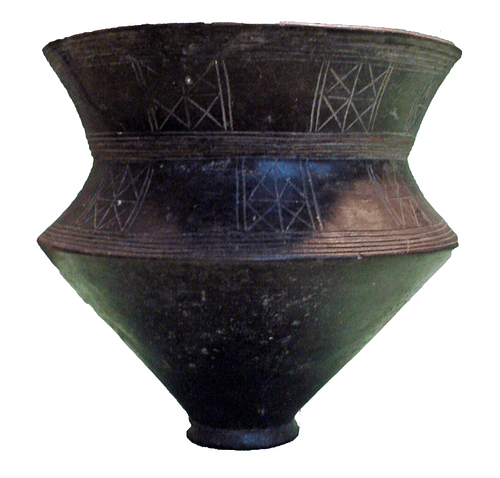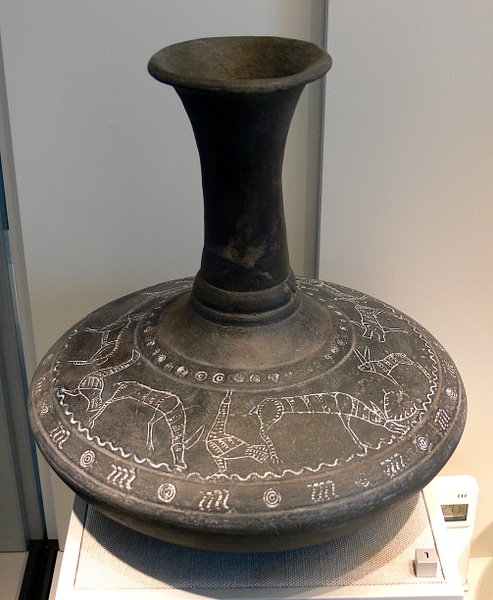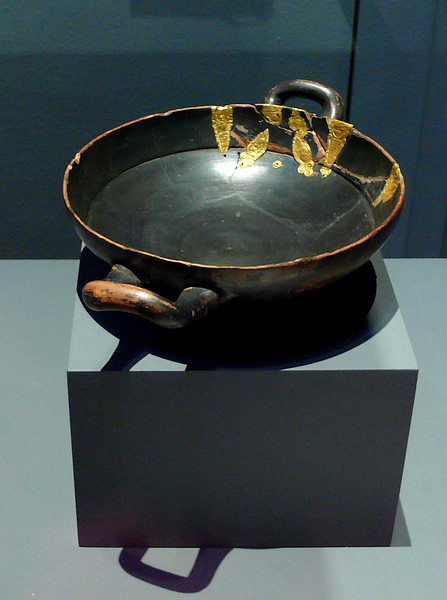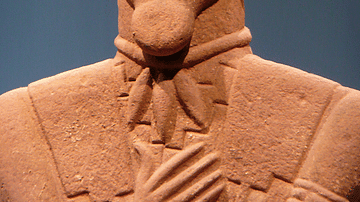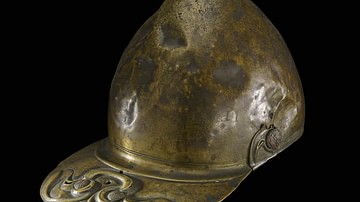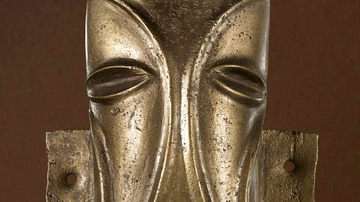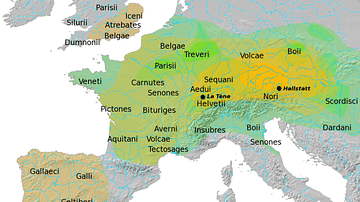
The pottery of the ancient Celts, although produced over great distances in space and time, shares several common features no matter where it was made, illustrating that there was contact between people living as far apart as Brittany and the Danube basin. Vessels are very often elegantly curved in form and may be dark in colour or red with black decoration. Animals were a favourite motif and could be incised, painted, or stamped onto pottery of all kinds. Curvilinear decoration was another common feature as Celtic artists filled spaces and emphasised the curves of the vessel. In addition to their own pottery, the Celts also appreciated that of their neighbours, with many gravesites containing prestige vessels and cups originally from the cultures of the Classical Mediterranean and beyond.
Common Themes
As dealing with any aspect of the ancient Celts, a treatment of their pottery must include the cautionary note that for craftworkers producing goods across Europe from Iberia to Bohemia and over a period of a millennium from 700 BCE to 400 CE, only generalised observations can be made. The Celts themselves had no concept that they were part of a wider European Iron Age culture with ties of language, religion, and art to other groups. In addition, within these Celtic groups, there were great regional variations. Further, Celts in different parts of Europe were influenced differently by whoever they came directly into contact with, whether that be Greeks, Romans, Thracians, or other Celts, and with those cultures they had indirect exposure to via traded goods such as those from Persia. Despite these difficulties, though, there are some common themes which can be identified in Celtic pottery.
Early Pottery
Celtic potters in central Europe were using the slow potter’s wheel in the Hallstatt Period (12-8th century BCE). A faster version of the wheel, which permitted finer pottery to be made, then arrived from the 8th century BCE onwards. This faster wheel was introduced by Mediterranean cultures. From the 5th to 3rd century BCE specialised workshops were established across Europe from the Pyrenees to Romania. One notable example being La Graufesenque in southern France where many potters working there left their names scratched on burnt pottery shards. There are particularly dense finds of stamped pottery in what is today’s Germany and the Danube basin, and Brittany. As the historian B. Cunliffe notes:
The high technical quality of this ware and the standardized range of motifs and motif arrangements suggest a shared set of cultural values and perhaps a degree of centralization in production. Outliers of the generalized style in western Brittany raises interesting questions about the nature of contact at the time.
(266)
Early Celtic pottery is usually plain and dark in colour - black and browns being most common. Despite this drabness, vessels were well-finished and highly polished. Early pottery vessels copied those made in bronze and mixed curved forms with sharp angles. Common shapes are the amphora with scroll (volute) or S-shaped handles. One early form, prevalent from the 6th century BCE, is tripartite carinated pottery. These vessels are made from three separate pieces, each with straight sides, which when assembled create an angular form. A fine example from northern France and dating to the 5th century BCE is now in the British Museum. It is black, polished, and incised with X-shaped motifs and lines, some of which still show traces of paint in red and white, although this may have been added by subsequent owners. The tripartite form came in a variety of designs, but bases are usually narrow, and the height is typically 1.5 times the diameter of the vessel.
The flattish flask with a long and narrow neck, known as the Linsenflasche, was common in central Europe in the 5th and 4th century BCE. An especially fine example of this type of flask was found in a 4th-century BCE burial at Matzhausen in Austria. The flask has an impressive animal frieze showing a hart, hind, roebuck, doe, boar, sow, gander, and goose, all framed within a stamped border. In addition, an incised hunting dog chases a hare around the side of the flask. The piece is now on display in the Museum für Vor- und Frühgeschichte in Berlin.
Forms which became common from the mid-4th century BCE onwards in Europe are generally curvaceous vessels, sometimes with a small pedestal. Smaller vessels tend to be almost spherical, diminishing significantly at the base and neck opening which is frequently shallow. Larger vessels tend to widen as they rise from a narrow base. There are rarely handles to interrupt the smooth lines of vessels. Meanwhile, in the far eastern side of the Celtic world in Hungary, pottery vessels are strikingly different with handles frequently added in the shape of human and animal heads, just like those which were added to metal vessels across the Celtic world.

Decoration
Most pottery items made for everyday use would have been plain or given only rudimentary decoration, but items for special occasions and the elite were a different matter. As in Celtic sculpture, fantastic animals appealed to the imagination of potters. An example is a tall beaker-like vessel from La Cheppe, Marne, France, which dates to the second half of the 5th century BCE. The vase is divided into two horizontal bands of incised decoration with each area having two dragon-like creatures facing each other. The vase is now on display in the Archaeological Museum of Saint-Germain-en-Laye in Paris.
Decoration in the form of animals and geometrical designs could be incised, an especially popular technique in the pottery of Brittany, or added as relief, a method widely used in Celtic Britain. Stamps, as in the Matzhausen flask, were also used to repeat uniform motifs on the same vessel such as lyres and elongated scrolls. From the 4th century BCE, a new form of decoration developed where red-fired vessels were then painted with a black coat which could be incised to leave images in red lines. Designs could be very intricate and with straight lines being avoided in favour of curvilinear forms.
Painted decoration now includes silhouettes of animals arranged in bands around the vessel. Horses were an especially popular motif. A good example of this painted style on a red background is a pedestal vase now in the British Museum, London, found in a cemetery at Prunay, Marne, France. It dates to the second half of the 4th century BCE. Often, as here, the pedestal and neck were left plain or given only a basic geometric pattern. Sometimes, the more decorated area of a vase was accentuated by making plain a large part of the vessel underneath, sometimes over half of the body.
The Celtic mastery of form perhaps reaches its zenith in the late 2nd-century BCE vase from Clermont-Ferrand in France. This bulbous vase is 43 cm (17 in) tall and is covered in distorted representations of animals, so much so, many are difficult to identify. There are certainly deer, but legs, antlers, and ears have been elongated to create swirling images that follow the contours of the vase. Like medieval Celtic art, the painter here seemed intent on filling every possible space available. The vase is now on display in La Musée Bargoin in Clermont-Ferrand. Other examples of this type of decoration, again with abstract animals or vegetal designs rendered with a few simple flowing strokes of the brush, sometimes have a background of dense hatched lines.
Imported Pottery
The Celts had a great admiration for fine pottery made in other cultures, which they acquired via trade, as diplomatic gifts, or as war booty. Tombs commonly have materials placed in them for use in Celtic feasts, and these sometimes include Greek wine cups, Etruscan kraters, and Roman amphorae, to name but a few examples which caught the Celtic eye. There are even examples where such prized vessels have been repaired. One 5th-century BCE Attic kylix or drinking cup shows repairs using gold leaf which has itself been decorated with leaf motifs. This cup, by no means unique, is on display in the Historisches Museum, Bern, Switzerland. Clearly, such hard-to-get vessels were an important status symbol and worthy of being entombed with great warriors and rulers.
